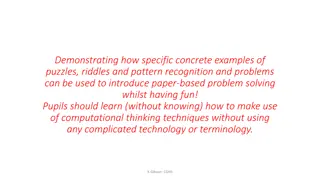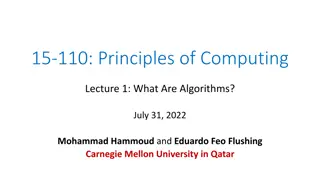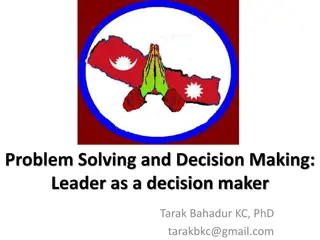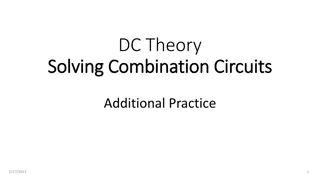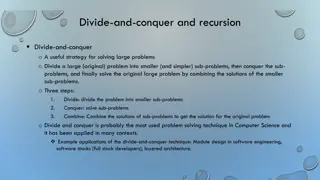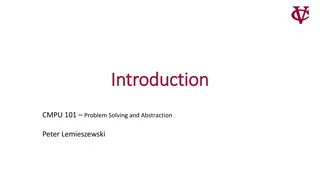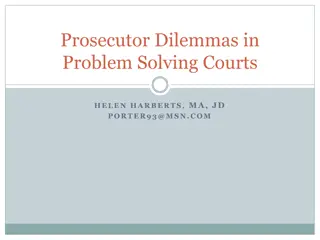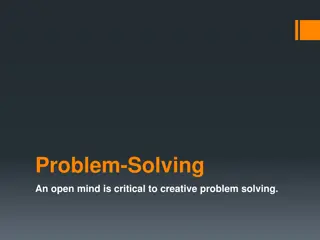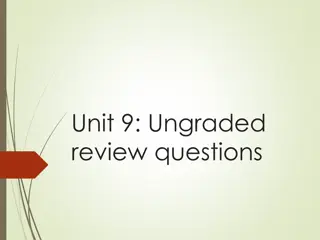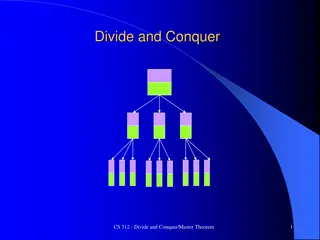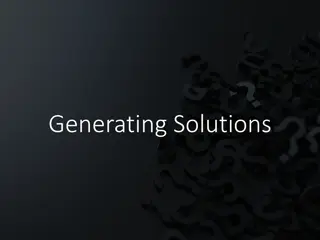Problem-Solving in Management Science
Utilizing a scientific approach, management science tackles a wide range of organizational problems through logical and mathematical problem-solving methods. Quantitative analysis plays a crucial role, offering valuable insights into both qualitative and quantitative factors. Decision-making in business involves evaluating multiple objectives, alternatives, biases, risks, and information needs to arrive at optimal solutions amidst changing environments and time constraints.
Download Presentation

Please find below an Image/Link to download the presentation.
The content on the website is provided AS IS for your information and personal use only. It may not be sold, licensed, or shared on other websites without obtaining consent from the author.If you encounter any issues during the download, it is possible that the publisher has removed the file from their server.
You are allowed to download the files provided on this website for personal or commercial use, subject to the condition that they are used lawfully. All files are the property of their respective owners.
The content on the website is provided AS IS for your information and personal use only. It may not be sold, licensed, or shared on other websites without obtaining consent from the author.
E N D
Presentation Transcript
Problem Solving Management science uses a scientific approach for solving management problems It is used in a variety of organizations to solve many different types of problems It encompasses a logical mathematical approach to problem solving Mathematical tools have been used for thousands of years Quantitative analysis can be applied to a wide variety of problems One must understand: the specific applicability of the technique, its limitations and its assumptions 2
Overview of Quantitative Analysis Scientific Approach to Managerial Decision Making Consider both Quantitative and Qualitative Factors Quantitative Analysis Meaningful Information Raw Data 3
Analyses Quant.Analysis Logic Historic Data Marketing Research Scientific Analysis Modeling Decision Problem ? Qual. Analysis Weather State and federal legislation New technological breakthroughs Election outcome 4
Typical Business Decision Aspects Several, possibly contradictory objectives Many alternatives Unevaluated alternatives Decision may be made by a group Group member biases Results can occur in the future Attitudes towards risk Need information Gathering information takes time and expense Too much information What-if analysis, Scenarios Trial-and-error experimentation may result in a loss Experimentation with the real system - only once Changes in the environment can occur continuously Time pressure 5
Decision Making We spend a significant portion of our time and psychic energy making decisions. Our decisions shape our lives: who we are, what we are, where we are, how successful we are, how happy we are all derive in large part from our decisions In order to raise our odds of making a good decision, we have to learn to use a good decision making process one that gets us to the best solution with a minimal loss of time, energy, money, etc... 6
Decision Making Decision making may be defined as: Intentional and reflective choice in response to perceived needs (Kleindorfer et al., 1993) Decision maker s (DM s) choice of one alternative or a subset of alternatives among all possible alternatives with respect to her/his goal or goals (Evren and lengin, 1992) Solving a problem by choosing, ranking, or classifying over the available alternatives that are characterized by multiple criteria (Topcu, 1999) 7
Effective Decision Making Process An effective decision making process will fulfill the following six criteria (Hammond et al., 1999): It focuses on what s important It is logical and consistent It acknowledges both subjective and objective factors and blends analytical with intuitive thinking It requires only as much information and analysis as is necessary to resolve a particular dilemma It encourages and guides the gathering of relevant information and informed opinion It is straightforward, reliable, easy to use, and flexible 8
Good Decision Making A key to good decision making is to provide a structural method for incorporating the information, opinions, and preferences of the various relevant people into the decision making process (Kirkwood, 1997) A good decision is based on logic uses all available resources evaluates all possible alternatives utilizes a quantitative method 9
Basic Concepts Problems Variables Objective Criteria Attributes Alternatives Participants in the decision making process (problem stakeholders) 10
Problem A felt difficulty A gap or obstacle to be circumvented Dissatisfaction with a purposeful state A perception of a variance, or gap, between the present and some desired state of affairs Three conditions characterise a problem (Evans, 1989): There are alternate courses of action available from which to choose The choice of a course of action can have a significant effect on the future There is some doubt as to which course of action to select 11
Problem An undesirable situation that is significant to and may be solvable by some agent, although probably with difficulty (Smith, 1989). Key elements of this definition: the gap between preferences and reality, the importance of remedying this gap, the expected difficulty of doing so. 12
Variables An objective is a statement of something that one desires to achieve A criterion is a tool allowing to compare alternatives according to a particular significance axis or a point of view (Bouyssou, 1990) An attribute measures the degree in which an objective is achieved (Keeney, 1996) An attribute represents the basic characteristic, quality, or efficiency parameter of an alternative (Evren and Ulengin, 1992) 13
Attributes Classification: Function type Benefit attributes Offer increasing monotonic utility. Greater the attribute value the more its preference Cost attributes Offer decreasing monotonic utility. Greater the attribute value the less its preference Nonmonotonic attributes Offer nonmonotonic utility. The maximum utility is located somewhere in the middle of an attribute range 14
Attributes Classification: construction type Natural attributes Those in general use that have a common interpretation to everyone Constructed (subjective) attributes Made up of verbal verbal descriptions of pre-described levels Proxy (indirect) attribute If measuring the degree of achievement is inadequate, it may be necessary to utilize an indirect measure 15
Alternative Alternatives is the set of actions, objects, candidates, decisions... To be explored during the decision process Alternative set may be defined by: Listing its members when it is finite and sufficiently small (MADM) Stating the properties which characterize its elements when it is infinite or finite but too large for an enumeration to be possible (MODM) 16
Problem Stakeholders The problem owner The person or group who has control over certain aspects of the problem situation, in particular over the choice of action to be taken. Most often, the problem owner is the decision maker. The problem user Uses the solution and/or executes the decisions approved by the problem owner or decision maker. Has no authority to change the decision The problem customer The beneficiary or victim of the consequences of using the solution The problem solver Decision Analyst who analyzes the problem and develops a solution for approval by the problem owner 17
Managerial Decision Making Decision making: the process by which managers respond to opportunities and threats by analyzing options, and making decisions about goals and courses of action. Decisions in response to opportunities: managers respond to ways to improve organizational performance. Decisions in response to threats: occurs when managers are impacted by adverse events to the organization. 18
Types of Decision Making Programmed Decisions: routine, almost automatic process. Managers have made decision many times before. There are rules or guidelines to follow. Example: Deciding to reorder office supplies. Non-programmed Decisions: unusual situations that have not been often addressed. No rules to follow since the decision is new. These decisions are made based on information, and a manger s intuition, and judgment. Example: Should the firm invest in a new technology? 19
The Classical Model Classical model of decision making: a prescriptive model that tells how the decision should be made. Assumes managers have access to all the information needed to reach a decision. Managers can then make the optimum decision by easily ranking their own preferences among alternatives. Unfortunately, managers often do not have all (or even most) required information. 20
The Classical Model List alternatives & consequences Assumes all information is available to manager Assumes manager can process information Rank each alternative from low to high Assumes manager knows the best future course of the organization Select best alternative 21
The Administrative Model Administrative Model of decision making: Challenged the classical assumptions that managers have and process all the information. As a result, decision making is risky. Bounded rationality: There is a large number of alternatives and information is vast so that managers cannot consider it all. Decisions are limited by people s cognitive abilities. Incomplete information: most managers do not see all alternatives and decide based on incomplete information. 22
Why Information is Incomplete Uncertainty & risk Ambiguous Information Incomplete Information Time constraints & information costs 23
Incomplete Information Factors Incomplete information exists due to many issues: Risk: managers know a given outcome can fail or succeed and probabilities can be assigned. Uncertainty: probabilities cannot be given for outcomes and the future is unknown. Many decision outcomes are not known such as a new product introduction. Ambiguous information: information whose meaning is not clear. Information can be interpreted in different ways. 24
Incomplete Information Factors Time constraints and Information costs: Managers do not have the time or money to search for all alternatives. This leads the manager to again decide based on incomplete information. Satisficing: Managers explore a limited number of options and choose an acceptable decision rather than the optimum decision. This is the response of managers when dealing with incomplete information. Managers assume that the limited options they examine represent all options. 25
Decision Making Process Structuring the Problem Constructing the Decision Model Analyzing (solving) the Problem 1. 2. 3. 26
Approach I Define the problem Develop a model Acquire data Develop a solution Test the solution Analyze the results and perform sensitivity analysis Implement the results 28
Define the Problem All else depends on this Clear and concise statement required May be the most difficult step Must go beyond symptoms to causes Problems are related to one another Must identify the right problem May require specific, measurable objectives 29
Develop the Model Model: representation of a situation Models: physical, logical, scale, schematic or mathematical Models: variables (controllable or uncontrollable) and parameters Controllable variables decision variables Models must be: solvable realistic easy to understand easy to modify 30
Acquire Data Accurate data is essential (GIGO) Data from: company reports company documents interviews on-site direct measurement statistical sampling 31
Develop a Solution Manipulate the model, find the best solution Solution: practical implementable Various methods: solution of equation(s) trial and error complete enumeration implementation of algorithm 32
Test the Solution Must test both Input data Model Determine: Accuracy Completeness of input data collect data from a different sources and compare Check results for consistency Do they make sense? Test before analysis! 33
Analyze the Results Understand the actions implied by the solution Determine the implications of the action Conduct sensitivity analysis - change input value or model parameter and see what happens Use sensitivity analysis to help gain understanding of problem (as well as for answers) 34
Implement the Results Incorporate the solution into the company Monitor the results Use the results of the model and sensitivity analysis to help you sell the solution to management 35
Approach II Recognize need for a decision Frame the problem Generate & assess alternatives Choose among alternatives Implement chosen alternative Learn from feedback 36
Decision Making Steps 1. Recognize need for a decision: Managers must first realize that a decision must be made. Sparked by an event such as environment changes. 2. Generate alternatives: managers must develop feasible alternative courses of action. If good alternatives are missed, the resulting decision is poor. It is hard to develop creative alternatives, so managers need to look for new ideas. 3. Evaluate alternatives: what are the advantages and disadvantages of each alternative? Managers should specify criteria, then evaluate. 37
Decision Making Steps 4. Choose among alternatives: managers rank alternatives and decide. When ranking, all information needs to be considered. 5. Implement choose alternative: managers must now carry out the alternative. Often a decision is made and not implemented. 6. Learn from feedback: managers should consider what went right and wrong with the decision and learn for the future. Without feedback, managers never learn from experience and make the same mistake over. 38
Evaluating Alternatives Is the possible course of action: Legal? Ethical Economical? Practical? 39
Evaluating Alternatives Is it legal? Managers must first be sure that an alternative is legal both in this country and abroad for exports. Is it ethical? The alternative must be ethical and not hurt stakeholders unnecessarily. Is it economically feasible?Can our organization s performance goals sustain this alternative? Is it practical? Does the management have the capabilities and resources to do it? 40
Modeling in the Real World Models are complex Models can be expensive Models can be difficult to sell Models are used in the real world by realorganizations to solve real problems 41
Example of Model Construction Problem Definition Information and Data: - Business firm makes and sells a steel product - Product costs $5 to produce - Product sells for $20 - Product requires 4 tons of steel to make - Firm has 100 tons of steel Business problem: Determine the number of units to produce to make the most profit given the limited amount of steel available. 42
Example of Model Construction Mathematical Model Variables: x = number of units (decision variable) Z = total profit Model: Z = $20x - $5x (objective function) 4x = 100 tons of steel (resource constraint) Parameters: $20, $5, 4 tons, 100 tons (known values) Formal specification of model: maximize Z = $20x - $5x subject to 4x = 100 43
Model Building Break-Even Analysis (1 of 7) Used to determine the number of units of a product to sell or produce (i.e. volume) that will equate total revenue with total cost. The volume at which total revenue equals total cost is called the break-even point. Profit at break-even point is zero. 44
Model Building Break-Even Analysis (2 of 7) Model Components Fixed costs (cf) - costs that remain constant regardless of number of units produced Variable cost (cv) - unit cost of product Total variable cost (vcv) - function of volume (v) and variable per-unit cost Total cost (TC) - total fixed cost plus total variable cost Profit(Z) - difference between total revenue vp (p=price) and total cost: Z = vp - cf - vcv 45
Model Building Break-Even Analysis (3 of 7) Computing the Break-Even Point The break-even point is that volume at which total revenue equals total cost and profit is zero: V = cf/(p-cv) Example: Western Clothing Company cf = $10000 cv = $8 per pair p = $23 per pair v = 666.7 pairs, break-even point 46
Model Building Break-Even Analysis (4 of 7) Graphical Solution Break-even model 47
Model Building Break-Even Analysis (5 of 7) Sensitivity Analysis (price) 48 Break-even model with a change in price
Model Building Break-Even Analysis (6 of 7) Sensitivity Analysis (variable cost) Break-even model with a change in variable cost 49
Model Building Break-Even Analysis (7 of 7) Sensitivity Analysis (fixed cost) Break-even model with a change in fixed cost 50









